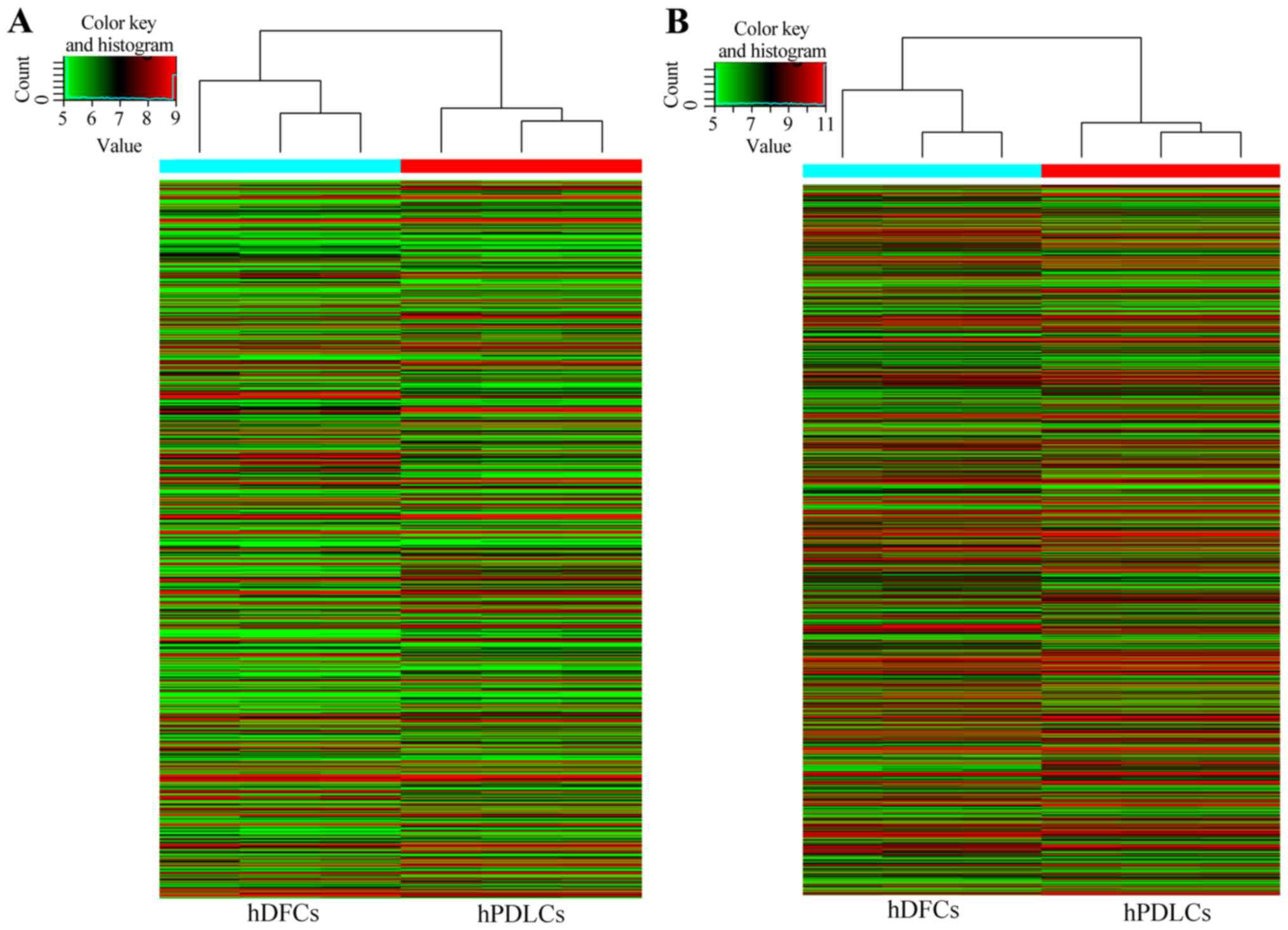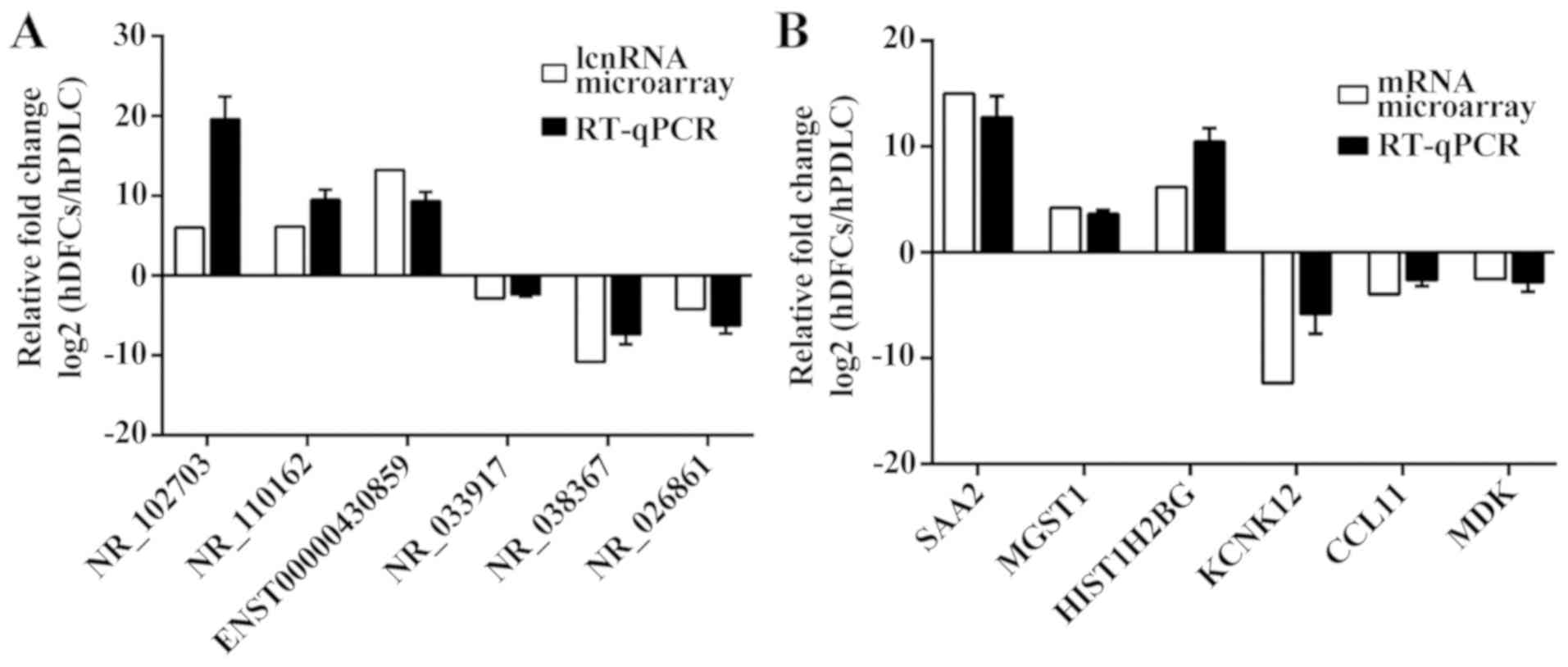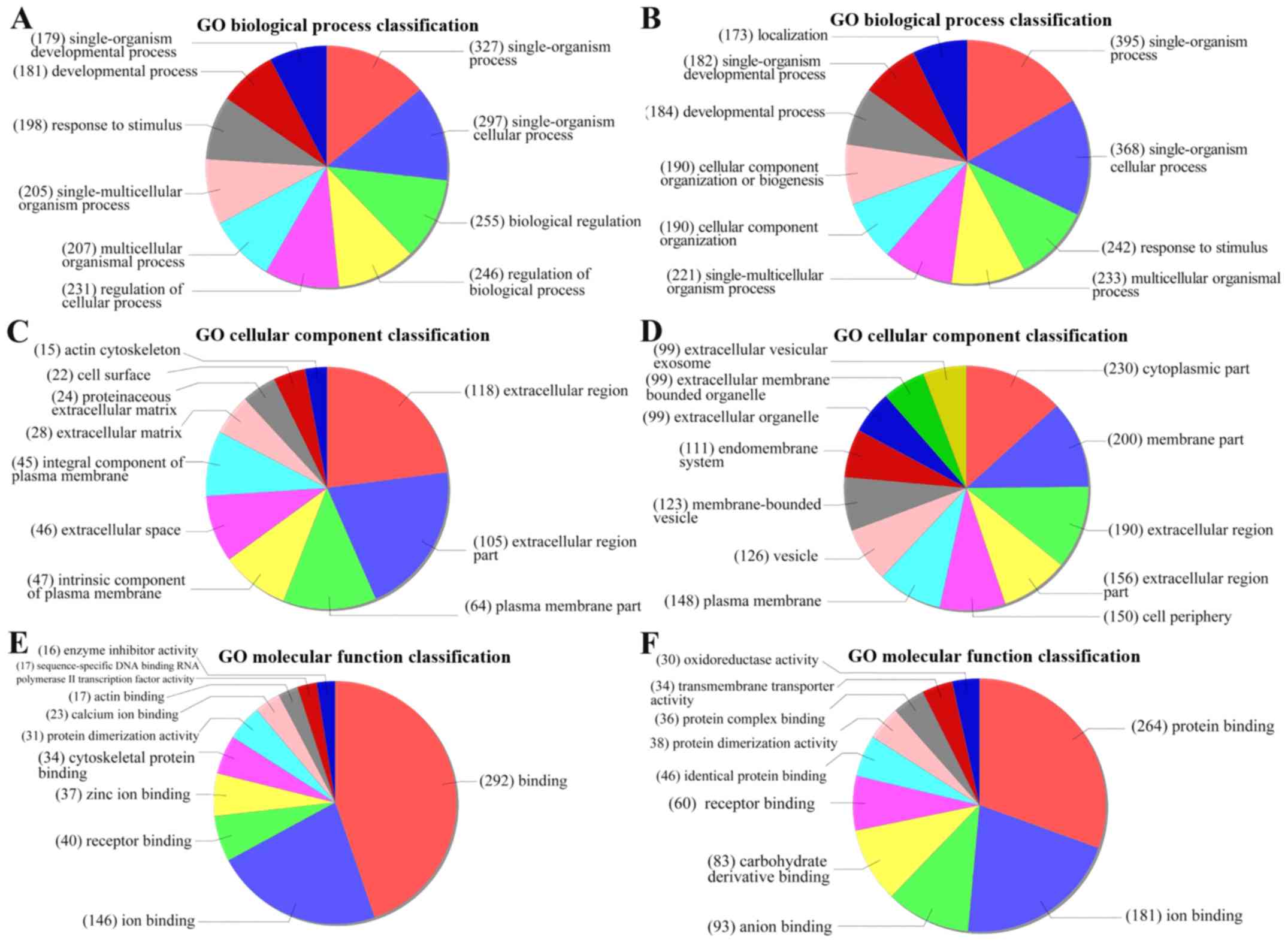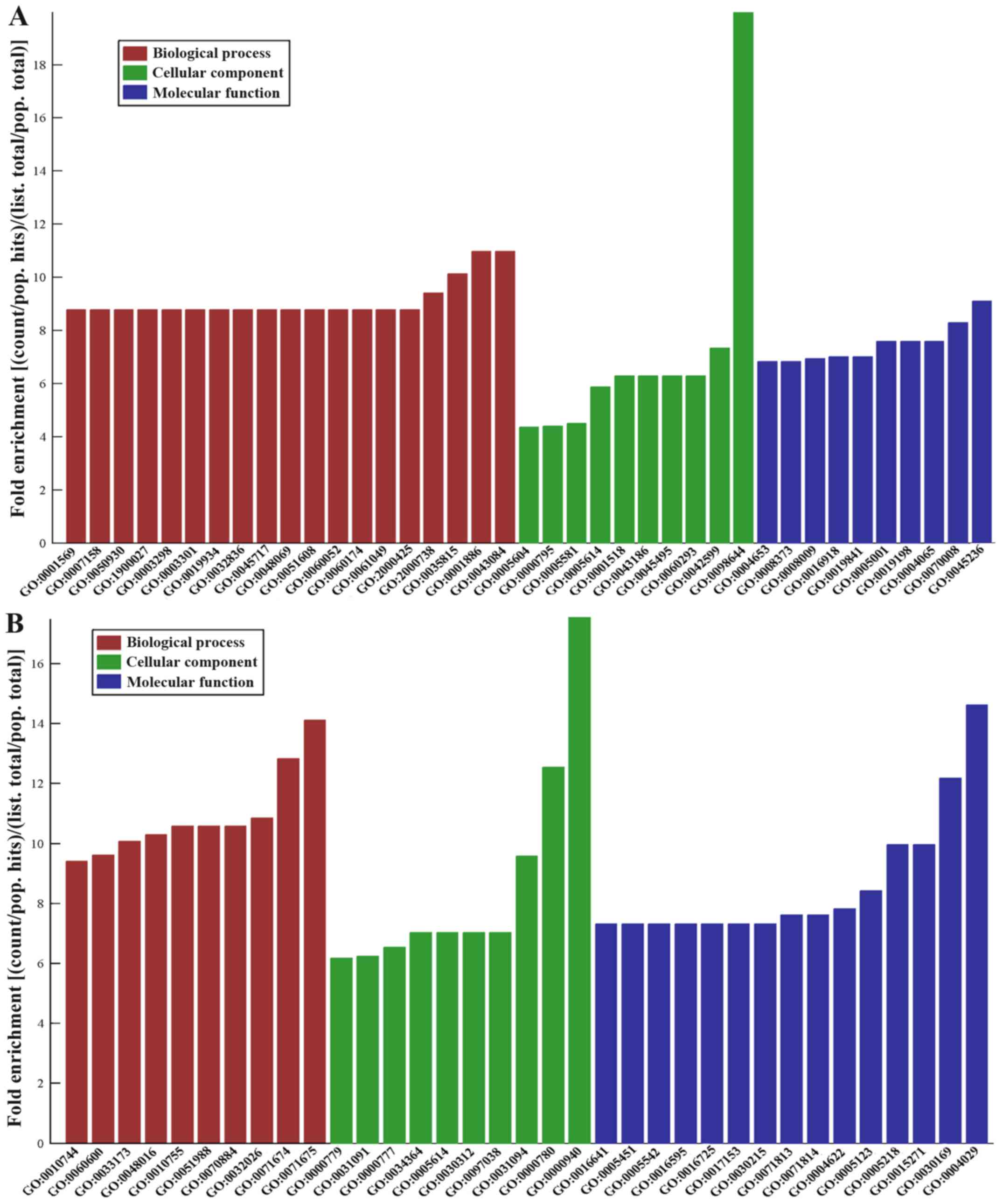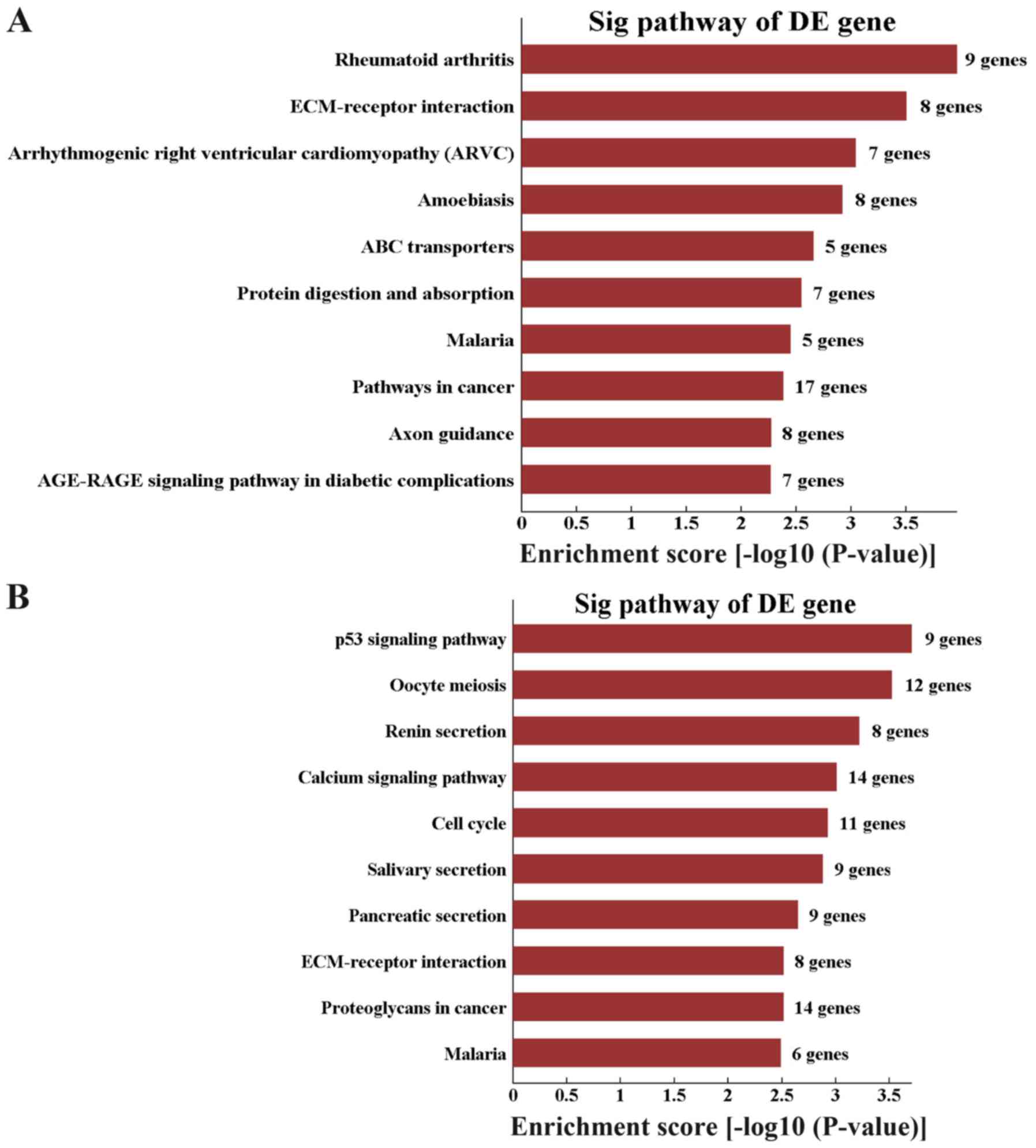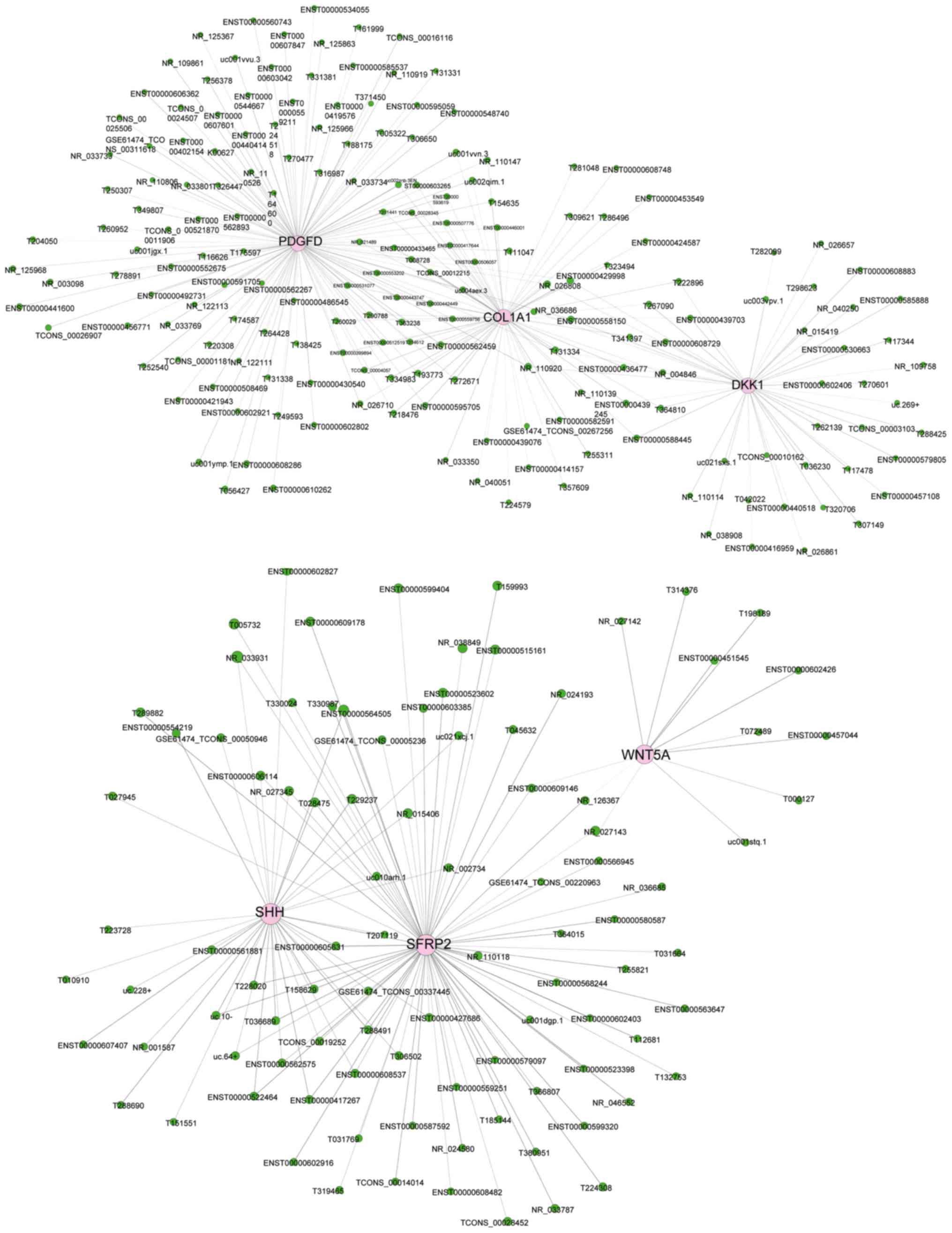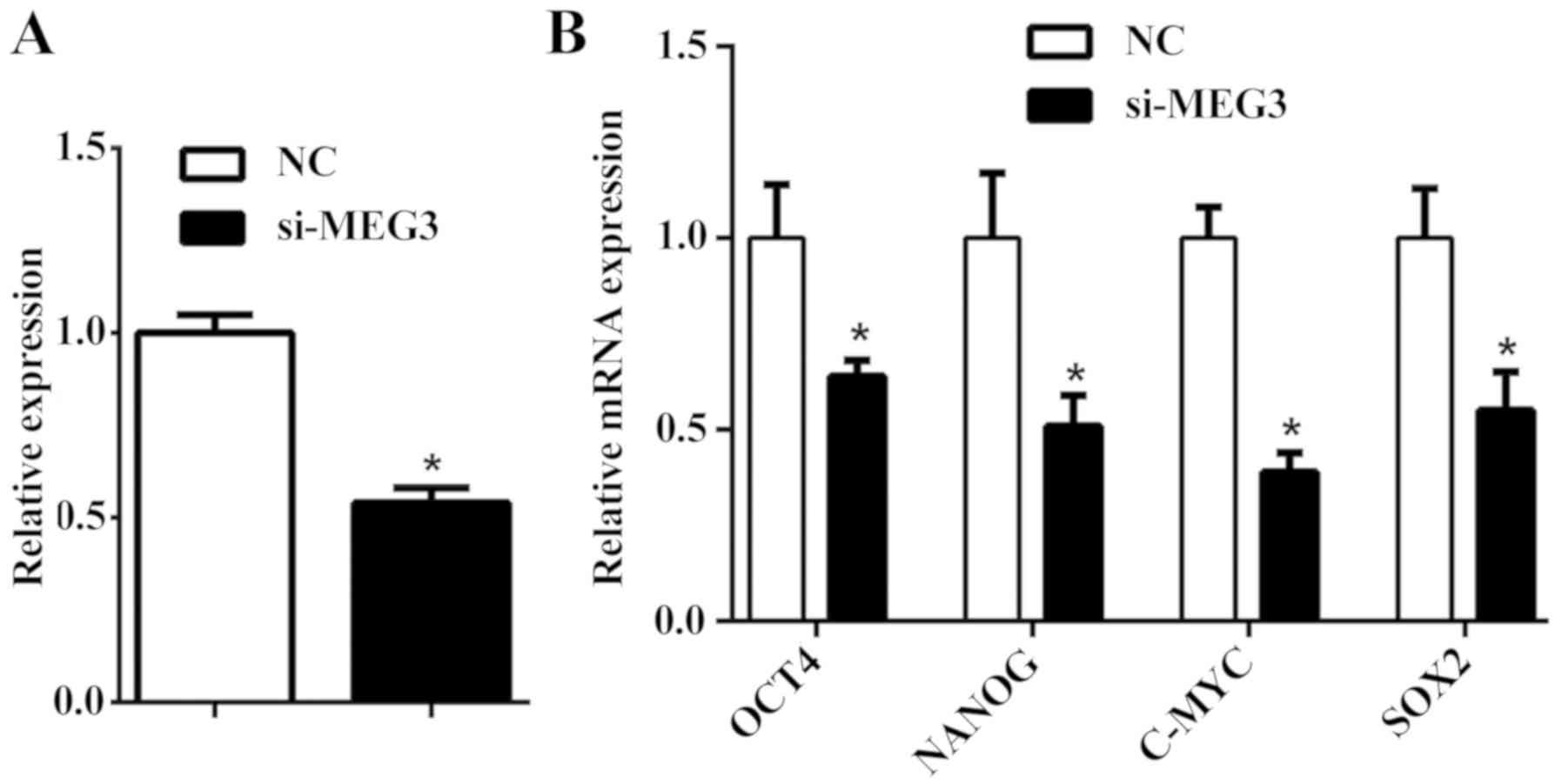|
1
|
Cho MI and Garant PR: Development and
general structure of the periodontium. Periodontol 2000. 24:9–27.
2000. View Article : Google Scholar : PubMed/NCBI
|
|
2
|
Itaya S, Oka K, Ogata K, Tamura S,
Kira-Tatsuoka M, Fujiwara N, Otsu K, Tsuruga E, Ozaki M and Harada
H: Hertwig's epithelial root sheath cells contribute to formation
of periodontal ligament through epithelial-mesenchymal transition
by TGF-β. Biomed Res. 38:61–69. 2017. View Article : Google Scholar : PubMed/NCBI
|
|
3
|
Sowmya S, Chennazhi KP, Arzate H,
Jayachandran P, Nair SV and Jayakumar R: Periodontal specific
differentiation of dental follicle stem cells into osteoblast,
fibroblast, and cementoblast. Tissue Eng Part C Methods.
21:1044–1058. 2015. View Article : Google Scholar : PubMed/NCBI
|
|
4
|
Seo BM, Miura M, Gronthos S, Bartold PM,
Batouli S, Brahim J, Young M, Robey PG, Wang CY and Shi S:
Investigation of multipotent postnatal stem cells from human
periodontal ligament. Lancet. 364:149–155. 2004. View Article : Google Scholar : PubMed/NCBI
|
|
5
|
Menicanin D, Mrozik KM, Wada N, Marino V,
Shi S, Bartold PM and Gronthos S: Periodontal-ligament-derived stem
cells exhibit the capacity for long-term survival, self-renewal,
and regeneration of multiple tissue types in vivo. Stem Cells Dev.
23:1001–1011. 2014. View Article : Google Scholar : PubMed/NCBI
|
|
6
|
Guo S, Guo W, Ding Y, Gong J, Zou Q, Xie
D, Chen Y, Wu Y and Tian W: Comparative study of human dental
follicle cell sheets and periodontal ligament cell sheets for
periodontal tissue regeneration. Cell Transplant. 22:1061–1073.
2013. View Article : Google Scholar : PubMed/NCBI
|
|
7
|
Kashi K, Henderson L, Bonetti A and
Carninci P: Discovery and functional analysis of lncRNAs:
Methodologies to investigate an uncharacterized transcriptome.
Biochim Biophys Acta. 1859:3–15. 2016. View Article : Google Scholar : PubMed/NCBI
|
|
8
|
Ghosal S, Das S and Chakrabarti J: Long
noncoding RNAs: New players in the molecular mechanism for
maintenance and differentiation of pluripotent stem cells. Stem
Cells Dev. 22:2240–2253. 2013. View Article : Google Scholar : PubMed/NCBI
|
|
9
|
Schmitz SU, Grote P and Herrmann BG:
Mechanisms of long noncoding RNA function in development and
disease. Cell Mol Life Sci. 73:2491–2509. 2016. View Article : Google Scholar : PubMed/NCBI
|
|
10
|
Aprea J and Calegari F: Long non-coding
RNAs in corticogenesis: Deciphering the non-coding code of the
brain. EMBO J. 34:2865–2884. 2015. View Article : Google Scholar : PubMed/NCBI
|
|
11
|
Korostowski L, Sedlak N and Engel N: The
Kcnq1ot1 long non-coding RNA affects chromatin conformation and
expression of Kcnq1, but does not regulate its imprinting in the
developing heart. PLoS Genet. 8:e10029562012. View Article : Google Scholar : PubMed/NCBI
|
|
12
|
Lv J, Huang Z, Liu H, Liu H, Cui W, Li B,
He H, Guo J, Liu Q, Zhang Y and Wu Q: Identification and
characterization of long intergenic non-coding RNAs related to
mouse liver development. Mol Genet Genomics. 289:1225–1235. 2014.
View Article : Google Scholar : PubMed/NCBI
|
|
13
|
Herriges MJ, Swarr DT, Morley MP, Rathi
KS, Peng T, Stewart KM and Morrisey EE: Long noncoding RNAs are
spatially correlated with transcription factors and regulate lung
development. Genes Dev. 28:1363–1379. 2014. View Article : Google Scholar : PubMed/NCBI
|
|
14
|
Hassan MQ, Tye CE, Stein GS and Lian JB:
Non-coding RNAs: Epigenetic regulators of bone development and
homeostasis. Bone. 81:746–756. 2015. View Article : Google Scholar : PubMed/NCBI
|
|
15
|
Chen L, Song Z, Huang S, Wang R, Qin W,
Guo J and Lin Z: lncRNA DANCR suppresses odontoblast-like
differentiation of human dental pulp cells by inhibiting
wnt/β-catenin pathway. Cell Tissue Res. 364:309–318. 2016.
View Article : Google Scholar : PubMed/NCBI
|
|
16
|
Jia Q, Chen X, Jiang W, Wang W, Guo B and
Ni L: The regulatory effects of long noncoding RNA-ANCR on dental
tissue-derived stem cells. Stem Cells Int. 2016:31468052016.
View Article : Google Scholar : PubMed/NCBI
|
|
17
|
Viale-Bouroncle S, Klingelhöffer C, Ettl T
and Morsczeck C: The WNT inhibitor APCDD1 sustains the expression
of β-catenin during the osteogenic differentiation of human dental
follicle cells. Biochem Biophys Res Commun. 457:314–317. 2015.
View Article : Google Scholar : PubMed/NCBI
|
|
18
|
Wei M, Zhang M, Adams A and Duan Y: JNK
and AKT/GSK3β signaling pathways converge to regulate periodontal
ligament cell survival involving XIAP. Biochem Biophys Res Commun.
448:485–491. 2014. View Article : Google Scholar : PubMed/NCBI
|
|
19
|
Livak KJ and Schmittgen TD: Analysis of
relative gene expression data using real-time quantitative PCR and
the 2(-Delta Delta C(T)) method. Methods. 25:402–408. 2001.
View Article : Google Scholar : PubMed/NCBI
|
|
20
|
Ashburner M, Ball CA, Blake JA, Botstein
D, Butler H, Cherry JM, Davis AP, Dolinski K, Dwight SS, Eppig JT,
et al: Gene ontology: Tool for the unification of biology. The gene
ontology consortium. Nat Genet. 25:25–29. 2000. View Article : Google Scholar : PubMed/NCBI
|
|
21
|
Sellers ZP, Schneider G, Maj M and
Ratajczak MZ: Analysis of the paternally-imprinted DLK1-MEG3 and
IGF2-H19 tandem gene loci in NT2 embryonal carcinoma cells
identifies DLK1 as a potential therapeutic target. Stem Cell Rev.
14:823–836. 2018. View Article : Google Scholar : PubMed/NCBI
|
|
22
|
Peng S, Cao L, He S, Zhong Y, Ma H, Zhang
Y and Shuai C: An overview of long noncoding RNAs involved in bone
regeneration from mesenchymal stem cells. Stem Cells Int.
2018:82736482018. View Article : Google Scholar : PubMed/NCBI
|
|
23
|
Farzi-Molan A, Babashah S, Bakhshinejad B,
Atashi A and Fakhr TM: Down-regulation of the non-coding RNA H19
and its derived miR-675 is concomitant with up-regulation of
insulin-like growth factor receptor type 1 during neural-like
differentiation of human bone marrow mesenchymal stem cells. Cell
Biol Int. 42:940–948. 2018. View Article : Google Scholar : PubMed/NCBI
|
|
24
|
Gu X, Li M, Jin Y, Liu D and Wei F:
Identification and integrated analysis of differentially expressed
lncRNAs and circRNAs reveal the potential ceRNA networks during
PDLSC osteogenic differentiation. BMC Genet. 18:1002017. View Article : Google Scholar : PubMed/NCBI
|
|
25
|
Kunej T, Obsteter J, Pogacar Z, Horvat S
and Calin GA: The decalog of long non-coding RNA involvement in
cancer diagnosis and monitoring. Crit Rev Clin Lab Sci. 51:344–357.
2014. View Article : Google Scholar : PubMed/NCBI
|
|
26
|
Tsai MC, Manor O, Wan Y, Mosammaparast N,
Wang JK, Lan F, Shi Y, Segal E and Chang HY: Long noncoding RNA as
modular scaffold of histone modification complexes. Science.
329:689–693. 2010. View Article : Google Scholar : PubMed/NCBI
|
|
27
|
Li P, Zhang G, Li J, Yang R, Chen S, Wu S,
Zhang F, Bai Y, Zhao H, Wang Y, et al: Long noncoding RNA RGMB-AS1
indicates a poor prognosis and modulates cell proliferation,
migration and invasion in lung adenocarcinoma. PLoS One.
11:e1507902016.
|
|
28
|
Sheng N and Li Y, Qian R and Li Y: The
clinical significance and biological function of lncRNA RGMB-AS1 in
hepatocellular carcinoma. Biomed Pharmacother. 98:577–584. 2018.
View Article : Google Scholar : PubMed/NCBI
|
|
29
|
Choi YH, Kim YJ, Jeong HM, Jin YH, Yeo CY
and Lee KY: Akt enhances Runx2 protein stability by regulating
Smurf2 function during osteoblast differentiation. FEBS J.
281:3656–3666. 2014. View Article : Google Scholar : PubMed/NCBI
|
|
30
|
David D, Jagadeeshan S, Hariharan R, Nair
AS and Pillai RM: Smurf2 E3 ubiquitin ligase modulates
proliferation and invasiveness of breast cancer cells in a CNKSR2
dependent manner. Cell Div. 9:22014. View Article : Google Scholar : PubMed/NCBI
|
|
31
|
Li B, Chen P, Qu J, Shi L and Zhuang W, Fu
J, Li J, Zhang X, Sun Y and Zhuang W: Activation of LTBP3 gene by a
long noncoding RNA (lncRNA) MALAT1 transcript in mesenchymal stem
cells from multiple myeloma. J Biol Chem. 289:29365–29375. 2014.
View Article : Google Scholar : PubMed/NCBI
|
|
32
|
Sun Z, Yu W, Sanz Navarro M, Sweat M,
Eliason S, Sharp T, Liu H, Seidel K, Zhang L, Moreno M, et al: Sox2
and Lef-1 interact with Pitx2 to regulate incisor development and
stem cell renewal. Development. 143:4115–4126. 2016. View Article : Google Scholar : PubMed/NCBI
|
|
33
|
Santiago L, Daniels G, Wang D, Deng FM and
Lee P: Wnt signaling pathway protein LEF1 in cancer, as a biomarker
for prognosis and a target for treatment. Am J Cancer Res.
7:1389–1406. 2017.PubMed/NCBI
|
|
34
|
Kessenbrock K, Wang CY and Werb Z: Matrix
metalloproteinases in stem cell regulation and cancer. Matrix Biol.
44-46:184–190. 2015. View Article : Google Scholar : PubMed/NCBI
|
|
35
|
Bunch H: Gene regulation of mammalian long
non-coding RNA. Mol Genet Genomics. 293:1–15. 2018. View Article : Google Scholar : PubMed/NCBI
|
|
36
|
Levine AJ and Berger SL: The interplay
between epigenetic changes and the p53 protein in stem cells. Genes
Dev. 31:1195–1201. 2017. View Article : Google Scholar : PubMed/NCBI
|
|
37
|
Tonelli FM, Santos AK, Gomes DA, da Silva
SL, Gomes KN, Ladeira LO and Resende RR: Stem cells and calcium
signaling. Adv Exp Med Biol. 740:891–916. 2012. View Article : Google Scholar : PubMed/NCBI
|
|
38
|
Liu Q, Hu CH, Zhou CH, Cui XX, Yang K,
Deng C, Xia JJ, Wu Y, Liu LC and Jin Y: DKK1 rescues osteogenic
differentiation of mesenchymal stem cells isolated from periodontal
ligaments of patients with diabetes mellitus induced periodontitis.
Sci Rep. 5:131422015. View Article : Google Scholar : PubMed/NCBI
|
|
39
|
Xiang L, Chen M, He L, Cai B, Du Y, Zhang
X, Zhou C, Wang C, Mao JJ and Ling J: Wnt5a regulates dental
follicle stem/progenitor cells of the periodontium. Stem Cell Res
Ther. 5:1352014. View Article : Google Scholar : PubMed/NCBI
|
|
40
|
Ou L, Fang L, Tang H, Qiao H, Zhang X and
Wang Z: Dickkopf Wnt signaling pathway inhibitor 1 regulates the
differentiation of mouse embryonic stem cells in vitro and in vivo.
Mol Med Rep. 13:720–730. 2016. View Article : Google Scholar : PubMed/NCBI
|
|
41
|
Kikuchi A, Yamamoto H, Sato A and
Matsumoto S: Wnt5a: Its signalling, functions and implication in
diseases. Acta Physiol (Oxf). 204:17–33. 2012. View Article : Google Scholar : PubMed/NCBI
|
|
42
|
Yu CY and Kuo HC: The trans-spliced long
noncoding RNA tsRMST impedes human embryonic stem cell
differentiation through WNT5A-mediated inhibition of the
epithelial-to-mesenchymal transition. Stem Cells. 34:2052–2062.
2016. View Article : Google Scholar : PubMed/NCBI
|
|
43
|
Liu X, Tan GR, Yu M, Cai X, Zhou Y, Ding
H, Xie H, Qu F, Zhang R, Lam CU, et al: The effect of tumour
necrosis factor-alpha on periodontal ligament stem cell
differentiation and the related signaling pathways. Curr Stem Cell
Res Ther. 11:593–602. 2016. View Article : Google Scholar : PubMed/NCBI
|
|
44
|
Lee HS, Lee J, Kim SO, Song JS, Lee JH,
Lee SI, Jung HS and Choi BJ: Comparative gene-expression analysis
of the dental follicle and periodontal ligament in humans. PLoS
One. 8:e842012013. View Article : Google Scholar : PubMed/NCBI
|















